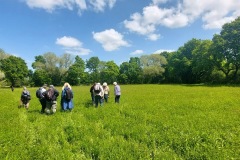Sykehouse Meadows: Flowers and Insects
Saturday 20th of May
Leaders:John Scott and Anna Thirlwell
Members present: Paul, Joyce Tom, Margaret, Nora, Gerri, John S, Anna, John N, Caroline
On Saturday 20 May 2023 a group of 10 Doncaster Naturalists visited the Went Valley Ings
SSSI meadows. The weather was perfect, warm and sunny. We walked from the car park,
beside the New Junction Canal, over the footbridge and onto the lane beside the Went
floodbank. We visited lots of small meadows surrounded by mature oaks , willows and a
variety of other shrubs. Great Burnet and Meadowsweet predominated in several fields,
with other species in among. Several insects of interest were found and subsequently
identified. Bird song was dominated by Cuckoo , Willow Warbler, Chiff Chaff and Blackcap.
The meeting ended abut 3 o’clock.
Birds:
Willow Warbler
Chiff Chaff
Blackcap
Blackbird
Robin
Buzzard
Great-spotted Woodpecker
Mute Swan
Wood Pigeon
Magpie
Butterflies:
Orange-tip
Brimstone
Holly Blue
Peacock
Red Admiral
Small Copper
Speckled Wood
Moths:
Latticed Heath
Mottled Umber larva
Dragonflies:
Blue-tailed Damselfly
Large Red Damselfly
Banded Demoiselle
Emperor Dragonfly ?
Beetles:
Soldier Beetle Cantharis rustica
Green Dock Beetle Gastrophysa viridula
Oak-leaf Roller Weevil Attelabus nitens
Flies:
Dark-edged Bee-fly Bombylius major
Mayflies:
Drake Mackerel Mayfly Ephemera
A few interesting plants:
Rough Hawk’s-beard Crepis biennis
Greater Stitchwort Stellaria holostea
Lesser Stitchwort S. graminea
Great Burnet Sanguisorba officinalis
Meadowsweet Filipendula ulmaria
Cuckoo flower (Milkmaid) Cardamine pratensis
Ragged-Robin Silene flos-cuculi
Creeping Jenny Lysimachia nummularia
Pale Sedge Carex pallicia
Black Sedge Carex nigra
Remote Sedge-Carex remota
Carnation Sedge Carex panic
Sweet Vernal grass Anthoxanthum odoratum
Meadow Foxtail Alopecurus pratensis
Sharp flowered rush
Wild Hop Humulus lupulus
Dyer’s Greenweed Genista tinctoria
Pepper-saxifrage Silaum silaus
Excursion Report of DNS Survey for Curimopsis nigrita & Bembidion humerale on Jack’s Piece, Lindholme, Hatfield Moors.
Friday 5th May 2023
Leader : Louise Hill
Ten intrepid bog-trotters (BCE, ML, PK, TS, JB, LAH, TP, MEO, JOHS & HRK) met at Lindolme Hall and after the necessary health and safety talk by leader Louise Hill set off onto Jack’s Piece, so named in memory of the late Jack Lyon a previous owner of the Hall and instrumental in recognising and safeguarding the unit.
The visit benefited from the presence of Brian Eversham (author of the 1996 Report on Bembidion humerale and Curimopsis nigrita) who talked the group through ideal micro habitats which might support Curimopsis nigrita particularly. The weather wasn’t ideal for the quest, in so much as there were only a few periods offering sun to tempt the target species out into the open and much of the site which held low growing mosses and bare peat was in shade, Bembidion humerale was found by Peter Kendall but no sign of Curimopsis nigrita despite extensive searching.
It should be emphasised that the purpose of the fieldwork was to survey for the two lowland raised mire specialities known from the site (Jack’s Piece). The ‘statistics’ reported here also include two other areas visited (details below). In total some 93 species of invertebrates were identified. Amongst that number were 12 species of Bembidion. B. humerale which was found on both Jack’s Piece and Crowle Moors . Frustratingly despite extensive searching (visual particularly but also with the use of a suction sampler) Curimopsis nigrita was not found.
Headline ‘stats’ include 9 heteroptera, 2 homoptera, 7 hymenoptera, 8 lepidoptera, 3 odonata and 32 coleoptera species amongst the ‘haul’
Five species of Cladonia lichens were noted on Jack’s Piece and of the six Lepidoptera species recorded, a male Emperor Moth which took an interest in HRK’s rucksack was perhaps the most noteworthy!
After returning to the cars, a smaller determined group (BCE, ML, TS, JOHS & HRK) headed for the car park at Ten Acre Lake where they walked along the firebreak adjacent to Lindholme Bank Road on Packard’s North Section 2. The western end was the wetter area.
The visit to Jack’s Piece at Lindholme was made possible by grant of access by Gomde. The area on Packard’s South is in public ownership, Open Access and managed by Natural England.
Crowle Moors South is a Lincolnshire Wildlife Trust nature reserve.
Postscript
Whilst Curimopsis nigrita was not located on Hatfield Moors, its ‘giant cousins’ Byrrhus cf pilula and Cytilus sericeus were found on Crowle Moors South on Sunday 7 May, in habitat that BCE was of a view would also hold C. nigrita. Whilst not part of the DNS excursion it was thought that the inclusion of these finds might be of interest to those involved with the survey visit to Lindholme.
Curimopsis nigrita is a Schedule 5, BAP, NERC Section 41 species and IUCN A species.






